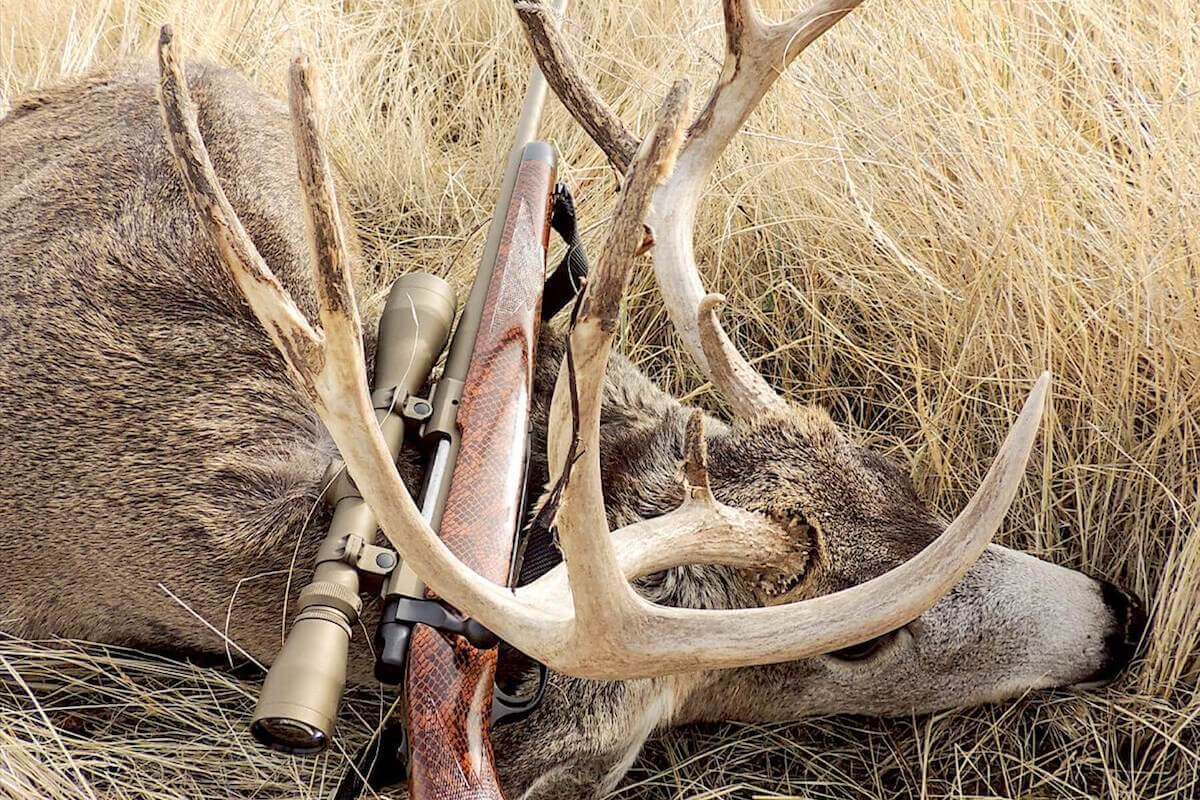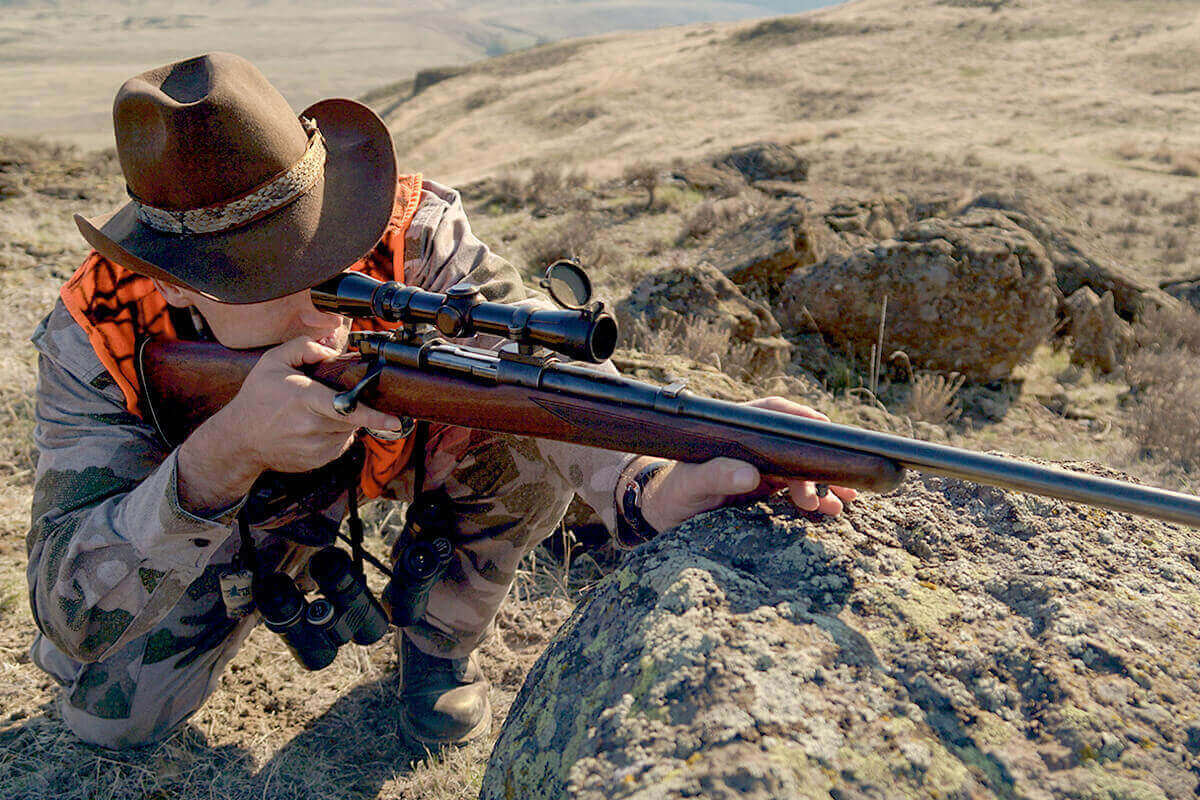
This mule deer buck’s antlers, still partially covered in velvet, gave it away in its rye grass bed. (Photo by Gary Lewis)
He looked like the biggest mule deer buck on the mountain. Still in velvet, he fed through sage brush and bitterbrush 800 yards or more from my position—too far for a certain shot. It was the fourth day of the hunt, and this was the biggest muley my partner and I had seen. A smaller buck was with him, and as we watched through the spotting scopes we saw there were eight does and fawns with the pair.
Shadows began to give way as the sun came up. I had won the coin toss, so it was my stalk, my play to make. Across the canyon, on the far slope, the mule deer lined out and moved across the hillside in single file—then simply vanished in apparently open country.
I quickly opened the topo map and saw the reason why. There was a bench up there, a narrow flat spot in just the right location and with just the right slope that from our location we could not see the deer as they moved across it. They had carefully chosen this travel route because it allowed them to be hidden from any danger below them.
My partner stayed with the scope while I went around the back of our hill, walked down the road and out of sight, then plunged down into the draw and started up the other side. It would take most of an hour to get there. What I did not know was that 10 more does and fawns had joined the herd.
When I hit the bench, I had the wind fully at my back and the does were streaming uphill, 18 of them in all. I turned away from the does to find the bucks. They were sneaking away in the opposite direction, using the mass movement of the does as a decoy. The smaller buck was just 10 yards from me, slipping around a juniper tree, while the big one was on its belly, trying to exit stage left. Those big velvet antlers gave him away, and I anchored him with a 7 mm bullet.
By the end of the first day of a hunting season, open-country mule deer feel the pressure and look for refuge in small pockets of cover that hunters tend to overlook.
Here are the types of habitat that deer will move into after opening day, and how you should think about hunting them.

THICKETS, WEDGES & SWAMPS
A mule deer buck does not require a lot of cover. Even a quarter of an acre, if it has feed and a place to bed, can hide a deer after opening day. In these habitat types, we should be looking for the browse mule deer need. If deer are using it, you’ll find their oval-shaped beds on the edges of small openings.
Everywhere it occurs, patches of mountain mahogany provide escape cover, shelter cover and food. If a patch of mahogany is big enough, the deer does not have to leave except to find water. It is so hard for anything to move silently through a stand of mahogany that most hunters go around them. Older bucks have patterned this human behavior and it’s why they hide in these places. Yet there are a couple of ways to hunt mahogany cover. If nearby trees allow for it, try a treestand. A little elevation and enough patience to give a bedding buck time to stand up can yield a shot. The same advantage can be had if nearby topography cooperates—sitting atop a nearby hill with good glass and watching the small openings is a good tactic for gun hunters.
Another type of hiding spot to consider is a wedge of cover and feed, either where two drainages come together or at the intersection of two roads or two-tracks. These places are easy to overlook as they are small, and most hunters fall into the trap of thinking all bucks are over the next set of hills roaming in big country. But the bucks know what hunters forget: It does not take much to hide a deer.
Swamps fall into the same category. In addition to cover, they can offer bucks three other advantages. The swampy ground can block the approach of potential predators from at least one direction, the wet ground can provide a cool oasis in hot country and, of course, the deer don’t have far to go to get a drink. Swamps hold deer.
To hunt these places, consider teaming up with others. Use the scent of one hunter on the upwind side to motivate deer to begin to move toward the exits of the cover. One or two other hunters in position on the downwind side of the cover can watch the escape trails.
When choosing their setup spots, the downwind hunters should remember that bucks that are not yet panicked do not simply head directly away from the upwind hunter. Instead, they look for a way to double back toward safer cover. Before they run, they will relocate and hide if they don’t think the upwind hunter knows they are there. Also keep in mind that mule deer bucks often hang out in twos or threes. The first one you see isn’t necessary the only buck or the biggest buck. Be patient.
COULEES, CAVES, FLATS & DITCHES
In open country, deer feed out on the tops of hills at night and then, as the sun gets up, filter into the coulees to find shade and cover in the long grasses. If there are few trees in an area, a buck will bed in tall rye grass or sagebrush. Limited shade does not necessarily limit bedding areas. Deer adapt.
Open country marked with brushy draws is some of the most difficult hunting for the mule deer hunter. People prepare for long shots in open country, but more often the shots are 15 to 75 yards when bucks leap from beds and bound away.
The longest coulees that are the hardest spots to reach from a road are the places to hunt. Long hikes are the rule, and long packs out with big deer can be the payoff. Spotting scopes can help in bigger canyons, but in small, brushy coulees they are often just extra weight. Two hunters work better than one, as two hunters walking 10 yards apart in tall rye can kick up a buck that would otherwise stay planted.
Deep drainage ditches offer some of the best bedding habitat in wheatland country. A buck can occupy a bed the size of a piano bench and be out of the direct sun. To look into these places, a hunter might have to walk several miles, thumb on the safety and scope dialed down to 2X, as the shots can be muzzle-close in some cases.
Once, I looked down into a cave and found three bucks tucked in the mouth. They were forkhorns and a 2×3—not bucks I wanted to shoot, but they did not move until I waved my hat.
PARKS, SLIDES & RIMROCK
In sub-alpine habitats, even in drier country, bigger mule deer bucks tend to gravitate to parks, shale slides and rimrock pockets where they can watch approaches from below and catch the wind lifted on morning breezes.
At the heads of springs or seeps, they benefit from the cooling breeze and from the moisture in the air. These slopes are dry, steep, well drained and often covered with loose rock that clatters when it shifts underfoot. Any sound in the rocks will alert the deer to danger.
The best approach in these situations is to glass from afar or find places where nearby elevated terrain can offer looks into bedding areas. Where a spotting scope cannot be set up for a good view, use a topo map to look for the pockets that will hold deer and make an X on the spot where a deer is likely to be. Then, hunt that spot like you believe a deer is bedded there.
Keep the wind in your face and perhaps post a partner to watch a side exit. If there is a spring, watch the spot to which the wind blows the cool air. Look for trails that go up through shale slides and look for the tips of antlers on the far sides of boulders.
In such places, the feed is often the red or purple while everything else is either green or yellow. There is a deer bedded nearby. The big buck is there. Somewhere. It is still early in the season. All you have is time. Use it wisely, be patient, and you’ll get your shot.
SCOUT TEAM
Don’t be outsmarted by mature bucks that send youngsters out ahead.
Mature bucks learn to use smaller bucks and does as decoys. A spike, forkhorn or small 3-point that travels in the company of larger bucks goes first down trails, through canyons and over fences. The smaller buck draws the attention of predators and hunters, giving the bigger buck a chance to sneak off in the opposite direction should it encounter danger. If the first deer you see coming out of even a small patch of cover is barely legal, hold your fire and keep watching—the bigger buck may be waiting to see if the smaller buck encounters danger before it exposes itself. That’s why it sometimes pays to let a smaller buck walk. A bigger buck might be a few steps behind.







